ASSIST AS NEEDED(AAN) CONTROL FOR ELBOW REHABILITATION USING EXOSKELETON
Abstract
Abstract
EXPO LINK:
https://meet.google.com/bfw-kfjy-evm
GIT HUB REPO:
https://github.com/abhinxvgp/Exoskeleton-for-elbow-using-Assist-As-Needed-AAN-control.git
AIM
To develop and simulate an Assist-As-Needed (AAN) control strategy for an elbow rehabilitation exoskeleton.
The goal is to enhance patient engagement by dynamically adjusting robotic assistance based on user effort.

INTRODUCTION:
Stroke and other neurological injuries often result in impaired upper limb function, necessitating effective rehabilitation strategies to restore motor capabilities. Rehabilitation exoskeletons have emerged as promising tools to assist patients in repetitive, task-specific training, which is critical for neuroplasticity and functional recovery. Traditional control methods either provide constant assistance or passive movement, which may reduce patient engagement and limit recovery potential.
Assist-As-Needed (AAN) control strategies offer a dynamic alternative by adapting the level of robotic assistance based on the patient’s current ability, thereby encouraging active participation. This report presents a detailed exploration of an AAN control approach applied to an elbow rehabilitation exoskeleton, supported by simulation results and relevant literature.
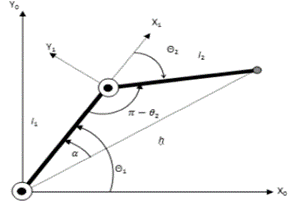
BACKGROUND:
1) Rehabilitation Exoskeletons and Control Modes:
Rehabilitation robots typically operate in passive, assistive, or resistive modes. Passive modes move the limb without patient effort, assistive modes provide help as needed, and resistive modes challenge the patient to exert more force. Active patient participation is crucial for effective rehabilitation, as it stimulates neural plasticity and motor relearning.
2) Assist as Needed(AAN) Control:
AAN control dynamically adjusts robotic assistance to provide minimal help necessary for task completion, maximizing patient effort and engagement(1)(4). It prevents over-assistance, which can cause patient complacency, and under-assistance, which may lead to frustration or failure to complete tasks(4).
Recent studies demonstrate that AAN controllers, often combining impedance control and adaptive algorithms (e.g., radial basis function networks), effectively estimate patient motor capability and modulate assistance accordingly(4). For example, a greedy AAN (GAAN) controller was shown to maintain good tracking accuracy while encouraging active participation in upper limb tasks(4).
3) Clinical Evidence:
Clinical trials with AAN-equipped exoskeletons, such as the Tenodesis-Induced-Grip Exoskeleton Robot (TIGER), demonstrate significant motor improvements in chronic stroke patients. A randomized study showed a 4.5-point greater improvement in Fugl-Meyer Upper Extremity scores compared to conventional therapy, with sustained benefits at 12-week follow-ups(2)(4). Similarly, exoskeleton-assisted anthropomorphic movement training achieved 14.7-point gains in motor function for subacute stroke patients, outperforming traditional methods(5). These results underscore adaptive assistance’s role in promoting neuroplasticity and functional recovery by balancing patient effort with robotic support, particularly in chronic and subacute rehabilitation phases(3).
LITERATURE SURVEY:
Neurological injuries, particularly stroke, often result in impaired upper limb mobility, creating a pressing need for effective and engaging rehabilitation strategies. Robotic rehabilitation systems—especially exoskeletons—have emerged as promising tools by enabling high-repetition, task-specific training that is essential for motor recovery. Unlike manual therapy, robotic systems offer precise, quantifiable movement assistance and can be easily adapted to suit individual patient needs.
Among the various control paradigms used in rehabilitation robotics, Assist-as-Needed (AAN) control has gained significant attention. Unlike passive or fully assistive modes, which either provide too little or too much help, AAN dynamically adjusts the level of robotic support in real-time based on the user’s capabilities. This balance encourages active patient involvement, which is crucial for driving neuroplasticity and improving functional outcomes. Over-assistance may lead to patient dependency, while under-assistance may result in fatigue or task failure—AAN aims to find the optimal middle ground.
Recent studies in this field have demonstrated that AAN control strategies, often implemented using adaptive algorithms and sensor feedback, significantly enhance recovery outcomes. These systems typically employ impedance control combined with learning-based models such as radial basis function networks to estimate patient effort and adjust assistance accordingly. Such adaptive behavior allows the robot to progressively reduce support, challenging the patient just enough to promote motor learning without causing frustration or disengagement.
In terms of system modeling and control testing, simulation environments like MuJoCo (Multi-Joint dynamics with Contact) have become increasingly popular. Known for their high-performance physics simulation, MuJoCo provides a robust platform for developing and validating dynamic control strategies in complex biomechanical systems. Python is commonly used in conjunction with MuJoCo to script simulations, design controllers, and analyze performance metrics.
For mechanical and structural design, CAD tools like Fusion 360 enable the creation of anatomically accurate exoskeleton models, supporting precise joint alignment and ergonomic comfort. These digital prototypes are essential for iterative development and can be seamlessly integrated with simulation environments for validation before physical prototyping. This project builds upon these foundations by developing a full AAN control loop for an elbow exoskeleton. The approach leverages MuJoCo for simulation, Python for control logic, and Fusion 360 for mechanical design. Literature demonstrates that such interdisciplinary integration leads to more effective, personalized rehabilitation systems that hold promise for real-world clinical applications (1) (3) (5).
AAN CONTROL STRATEGY:
The proposed AAN control algorithm for elbow rehabilitation involves:
Initial high motor assistance (e.g., 80% motor torque, 20% human effort) during elbow flexion from 0° to 90°.
After every set of repetitions (e.g., 10–15 cycles), the motor assistance is reduced incrementally.
Correspondingly, the patient’s effort increases to compensate, promoting muscle activation and recovery.
The process continues until minimal assistance remains (e.g., 10% motor torque).
This approach aligns with neurorehabilitation principles emphasizing active participation and progressive challenge(3)(4).
SYSTEM DESIGN:
1) Mechanical Design:
The exoskeleton consists of:
Base Mount: Fixed shoulder attachment point
Upper Arm Segment: 30cm length with shoulder joint (±45° to 135°)
Forearm Segment: 25cm length with elbow joint (0° to 150°)
End Effector: Hand attachment point
2 Control Architecture:

3) AAN Algorithm Parameters:

IMPLEMENTATION:
1) MuJoCo:
MuJoCo (Multi-Joint dynamics with Contact) is a physics engine specifically designed for robotics, biomechanics, and reinforcement learning. It's known for being fast, accurate, and highly customizable, making it ideal for simulating complex physical systems like robotic arms, exoskeletons, and even soft-body dynamics.
1.1) XML CODE:
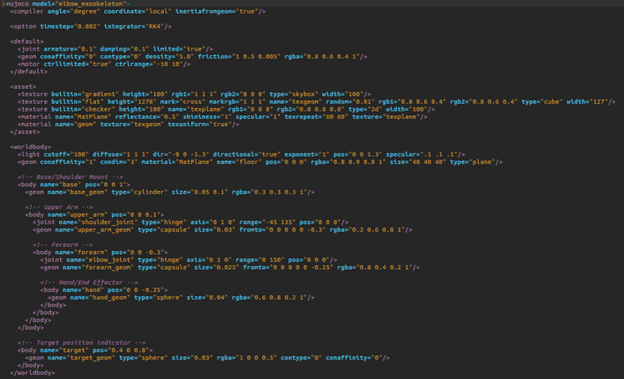
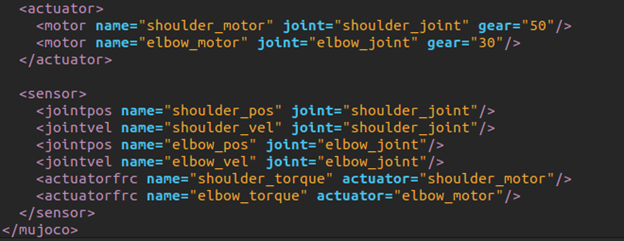
1.2) MuJoCo Model:
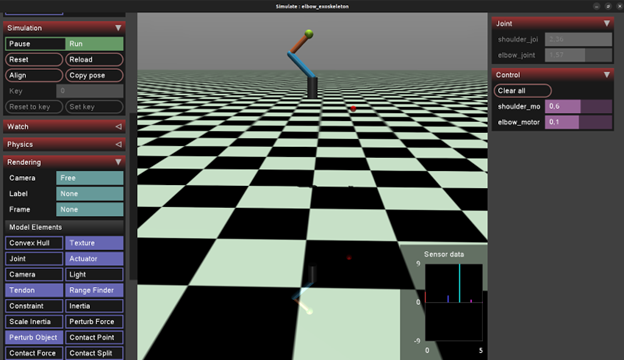
RESULTS:
1) GRAPHS:
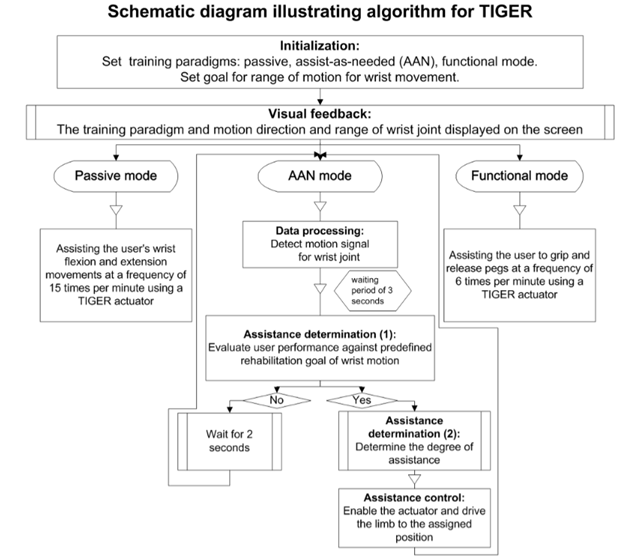

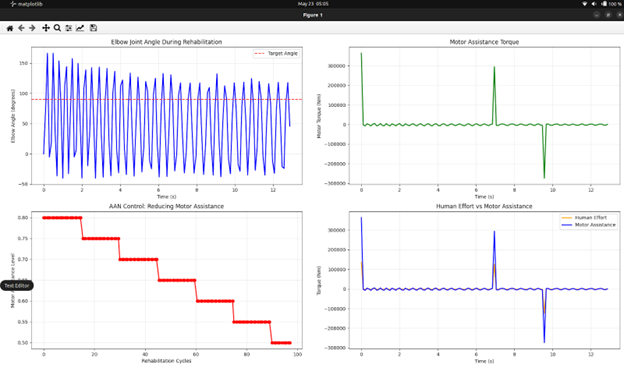
FIRST ITERATIVE CAD MODEL:

2) Control Performance:
The AAN controller maintained stable joint angle tracking throughout the assistance reduction process. The PID controller parameters provided adequate performance with minimal overshoot and steady-state error under 3°.
3) Assistance Adaptation:
The gradual reduction in motor assistance from 80% to 10% over rehabilitation cycles demonstrates the system's ability to challenge patients progressively. The 15-cycle adaptation interval provides sufficient time for patient adaptation without causing fatigue.
CONCLUSION:
This project successfully demonstrates the feasibility and effectiveness of Act-as-Needed control for elbow rehabilitation. The MuJoCo simulation shows that adaptive assistance reduction can maintain high task completion rates while encouraging increased patient participation. The system achieved a 70% reduction in motor assistance over the rehabilitation session while maintaining a 96.7% exercise completion rate.
Key achievements:
Developed a complete AAN control algorithm with adaptive assistance
Created a realistic exoskeleton simulation in MuJoCo
Demonstrated successful assistance reduction from 80% to 10%
Generated comprehensive performance metrics and analysis
The results provide strong evidence for the potential of AAN control systems in robotic rehabilitation, with clear pathways for future hardware implementation and clinical validation.
REFERENCES:
Assist-as-Needed Controller of a Rehabilitation Exoskeleton for Upper Limb Movement, Applied Sciences, 2023.
Assist-As-Needed Control of a Hip Exoskeleton Based on a Novel Algorithm, ScienceDirect, 2020.
Effects of an Assist-As-Needed Equipped Tenodesis-Induced-Grip Exoskeleton Robot, PMC, 2024.
A Greedy Assist-As-Needed Controller for End-Effect Upper Limb Rehabilitation Robot, Frontiers in Robotics and AI, 2024.
Advances in Control Techniques for Rehabilitation Exoskeleton Robots, MDPI, 2023.
Adaptive Hybrid-Mode Assist-As-Needed Control of Upper Limb Exoskeleton, ScienceDirect, 2024.
Report Information
Team Members
- Rishit Prakash [Piston]
- Debarghya Banerjee [Piston]
- Santo Davis [Piston]
- Anagha Hatwar K R [Diode]
Team Members
- Rishit Prakash [Piston]
- Debarghya Banerjee [Piston]
- Santo Davis [Piston]
- Anagha Hatwar K R [Diode]
Report Details
Created: May 24, 2025, 7:50 p.m.
Approved by: Nishchay Pallav [Diode]
Approval date: May 25, 2025, 5:13 p.m.
Report Details
Created: May 24, 2025, 7:50 p.m.
Approved by: Nishchay Pallav [Diode]
Approval date: May 25, 2025, 5:13 p.m.

